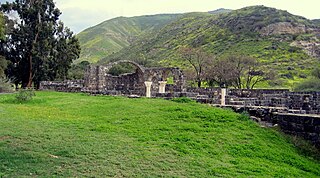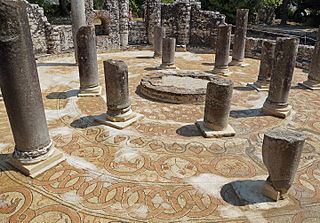
A mosaic is a pattern or image made of small regular or irregular pieces of colored stone, glass or ceramic, held in place by plaster/mortar, and covering a surface. Mosaics are often used as floor and wall decoration, and were particularly popular in the Ancient Roman world.

Capernaum was a fishing village established during the time of the Hasmoneans, located on the northern shore of the Sea of Galilee. It had a population of about 1,500 in the 1st century AD. Archaeological excavations have revealed two ancient synagogues built one over the other. A house turned into a church by the Byzantines is believed to have been the home of Saint Peter.

Mount Nebo is an elevated ridge located in Jordan, approximately 700 metres (2,300 ft) above sea level. Part of the Abarim mountain range, Mount Nebo is mentioned in the Bible as the place where Moses was granted a view of the Promised Land before his death. The view from the summit provides a panorama of the West Bank across the Jordan River valley. The city of Jericho is usually visible from the summit, as is Jerusalem on a very clear day. The biblical town of Nebo, now known as Khirbet al-Mukhayyat, is located 3.5 km away.

Dominus Flevit is a Roman Catholic church on the Mount of Olives, opposite the walls of the Old City of Jerusalem in Israel. During construction of the sanctuary, archaeologists uncovered artifacts dating back to the Canaanite period, as well as tombs from the Second Temple and Byzantine eras.

The Basilica of San Vitale is a late antique church in Ravenna, Italy. The sixth-century church is an important surviving example of early Christian Byzantine art and architecture. It is one of eight structures in Ravenna inscribed on the UNESCO World Heritage List. Its foundational inscription describes the church as a basilica, though its centrally-planned design is not typical of the basilica form. Within the Roman Catholic Church it holds the honorific title of basilica for its historic and ecclesial importance.

The scroll in art is an element of ornament and graphic design featuring spirals and rolling incomplete circle motifs, some of which resemble the edge-on view of a book or document in scroll form, though many types are plant-scrolls, which loosely represent plant forms such as vines, with leaves or flowers attached. Scrollwork is a term for some forms of decoration dominated by spiralling scrolls, today used in popular language for two-dimensional decorative flourishes and arabesques of all kinds, especially those with circular or spiralling shapes.

The Mshatta Facade is the decorated part of the facade of the 8th-century Umayyad residential palace of Qasr Mshatta, one of the Desert Castles of Jordan, which is now installed in the south wing of the Pergamon Museum in Berlin, Germany. It is part of the permanent exhibition of the Pergamon Museum of Islamic Art dedicated to Islamic art from the 8th to the 19th centuries. This was only a relatively small section of the full length of the facade, surrounding the main entrance; most of the wall was undecorated and remains in situ.

The Jericho synagogue dates to the late 6th or early 7th century CE and was discovered in Jericho in 1936. All that remains from the ancient prayer house is its mosaic floor, which contains an Aramaic inscription presenting thanks to the synagogue donors, and a well-preserved central medallion with the inscription "Shalom al Israel", meaning "Peace [up]on Israel". This led to the site also being known as Shalom Al Israel Synagogue.

Kursi is an archaeological site in the Golan Heights containing the ruins of a Byzantine monastery and identified by tradition as the site of Jesus' "Miracle of the Swine". Part of the archaeological site is now an Israeli national park. Kursi takes its name from the Talmudic site. A marble slab with Aramaic text discovered in December 2015 seems to indicate that the settlement had, as of ca. 500 CE, a Jewish or Judeo-Christian population.

Early Byzantine mosaics in the Middle East are a group of Christian mosaics created between the 4th and the 8th centuries in ancient Syria, Palestine and Egypt when the area belonged to the Byzantine Empire. The eastern provinces of the Eastern Roman Empire and its continuation, the Byzantine Empire, inherited a strong artistic tradition from pagan Late Antiquity. The tradition of making mosaics was carried on in the Umayyad era until the end of the 8th century. The great majority of these works of art were later destroyed but archeological excavations unearthed many surviving examples.

The Chapel of Saint Helena is a 12th-century Armenian church in the lower level of the Church of the Holy Sepulchre in Jerusalem, constructed during the Kingdom of Jerusalem. The Armenians call it the Chapel of St. Gregory the Illuminator, after the saint who brought Christianity to the Armenians.

The ancient synagogue of Gaza was built in 508 CE during the Byzantine period and was discovered in 1965. It was located in the ancient port city of Gaza, then known as "Maiumas", currently the Rimal district of Gaza City.

The Maon Synagogue is a 6th-century synagogue and archaeological site located in the Negev Desert near Kibbutz Nirim and Kibbutz Nir Oz. It is noted for its "magnificent" mosaic floor.

The Church of Hosios David is a late 5th-century church in Thessaloniki, Greece. During Byzantine times, it functioned as the katholikon of the Latomos Monastery, and was adorned with rich mosaic and fresco decoration, which was renewed in the 12th–14th centuries. The church is dedicated to David the Dendrite. Many surviving elements of the Byzantine decoration are of high artistic quality, especially the 5th-century apse mosaic the Icon of Christ of Latomos. Under Ottoman rule, the building was converted into a mosque, until it was reconsecrated as a Greek Orthodox church in 1921, thus receiving its present name. In 1988, this monument was included among the Paleochristian and Byzantine monuments of Thessaloniki on the list of World Heritage Sites by UNESCO.

The Vigna Randanini are Jewish Catacombs between the second and third miles of the Appian Way close to the Christian catacombs of Saint Sebastian, with which they were originally confused. The catacombs date between the 2nd and 5th-centuries CE, and take their name from the owners of the land when they were first formally discovered and from the fact that the land was used as a vineyard (vigna). While Vigna Randanini are just one of the two Jewish catacombs in Rome open to the public, they can only be visited by appointment. They are situated below a restaurant and a private villa and entrance is from the Via Appia Pignatelli side. These catacombs were discovered by accident in 1859, although there is evidence that they had been pillaged before then. They cover an area of 18,000 square metres and the tunnels are around 700 metres long, of which around 400 can be seen.
Dr. Michael Avi-Yonah was an Israeli archaeologist and historian. During his career he was a Professor of Archaeology at the Hebrew University of Jerusalem and served as secretary of Israel's Department of Antiquities.
Hadrianopolis in Paphlagonia was a city in southwestern Paphlagonia, Asia Minor, about 3km west of modern Eskipazar.

The baptistery at Butrint, is an archeological site in Vlorë County, Albania and part of the Butrint National Park, is a late antique structure known for its well-preserved mosaic pavement. The centrally planned, circular baptistery is also notable as an ancient Roman monument adapted to the needs of Christianity.

The Birds Mosaic is a Byzantine mosaic floor discovered in Caesarea Maritima.

















